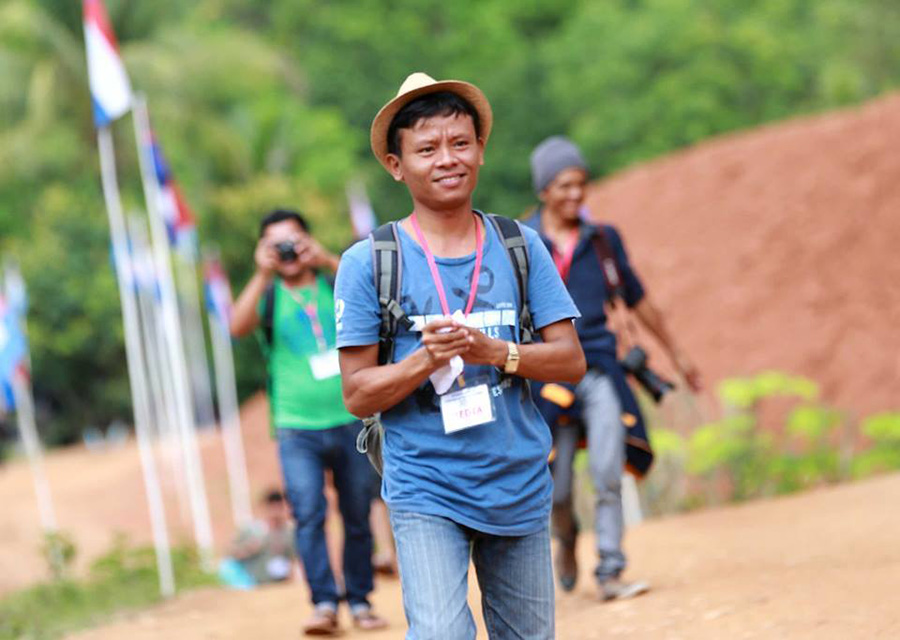Today marks the second day that The Irrawaddy’s senior reporter, Lawi Weng, is in detention in northern Shan State after he was arrested by the Myanmar Army on June 26 along with fellow journalists U Aye Nai and U Pyae Bone Naing of the Democratic Voice of Burma while reporting in the region.
We are re-posting one of Lawi Weng’s past articles to highlight his dedication and professionalism in reporting on conflict and to remind readers that he continues to be held, in an as yet-unknown location.
‘Surviving the Night’ was originally written on November 23, 2016. In this piece, Lawi describes long, cold hours in Shan State’s Kutkai Township listening to artillery shells fall in the distance as clashes occurred between the Tatmadaw and ethnic armed groups.
The sounds of guns and artillery fire made for a sleepless night on Monday in Nang Pha Lon village, located on the road from Lashio to Muse, in northern Shan State’s Kutkai Township.
It was 7 p.m. when the shooting started.
Our car, with eight people inside, was parked at a shop belonging to an ethnic Kachin woman. Hearing the guns nearby, she gathered her things in a small bag hung on her shoulder, preparing to run.
“Where would you hide?” I said, asking if she in fact had a bunker—she did not.
With nowhere to go, I returned to the car, where a friend of mine, Ma Noe, was waiting. We agreed to stay there, and leave the night to fate.
“It’s a matter of luck,” Ma Noe said. “If we have bad luck, artillery will fall on our car. But let’s anticipate that we will have good luck.”
There was nothing to say as the time passed. We just listened to the gunshots and artillery explosions in the distance—from whom they were being fired, we did not know. On Sunday, four ethnic armed groups—the Kachin Independence Army (KIA), the Ta’ang National Liberation Army, the Myanmar National Democratic Alliance Army and the Arakan Army—announced that together they had formed a Northern Alliance and began a joint offensive against the Burma Army along the Chinese border in northern Shan State. To date, more than 5,000 people have been displaced, and state media report that at least 10 people—both police and civilians—have been killed.
Dogs barked throughout Nang Pha Lon, and that, combined with the cold, made it impossible to sleep. We kept from using any light, worried that it would attract attention from the armed men nearby.
As we saw the early morning sun dawn on Tuesday, I felt thankful that we had been lucky as Ma Noe had predicted, and that we could proceed our journey.

Just outside Nang Pha Lon village, we soon discovered that over 100 vehicles, including large 12-wheel trucks, had been blocked from continuing onward by a group of KIA soldiers. Like us, they had spent the night in their cars, fearing the shells they could hear being fired from the surrounding mountains.
The previous afternoon—Monday—we had encountered KIA troops by the roadside who had demanded that each vehicle pay a fee in order to pass. Drivers of big trucks were required to pay 500,000 kyats (US$382); our smaller car got through for 50,000 kyats ($38).
At the checkpoint, our phones had been confiscated as well.
“It’s for security, and we will give it back soon,” said the KIA member who took my phone from me and from the other passengers in the car. We never got them back.
Some truck drivers refused to pay the fee in order to pass, claiming they did not have the money to do so, and the keys to their vehicles were seized. One KIA soldier held a handful of keys up for the line of waiting cars to see, pronouncing that we were paying a “yearly tax.”
“After you pay this, you don’t have to pay again for the whole year,” he said.
At one point, he shot his gun upward toward the sky, threatening to “destroy” any trucks for which the “tax” could not be paid. The congestion of seized vehicles meant that only small cars were able to pass.
Fifteen minutes past Nang Pha Lon, we encountered Burma Army soldiers intent on removing the KIA road block. We later heard that a truck driver was shot in the head when fighting broke out between the KIA and the Burma Army in the same area where we had been delayed.
The Kachin shopkeeper in Nang Pha Lon had said that the village’s precarious location meant that she had to exist between two armed forces—the KIA and the Burma Army. She explained that government troops had left the area near her house only two days before, and that KIA members had immediately taken their place.
“We are the people,” she said, “who are in the middle.”
But she decided that she would not run from the conflict anymore. Her market is her life, she said.
This article was originally published on November 23, 2016.

















